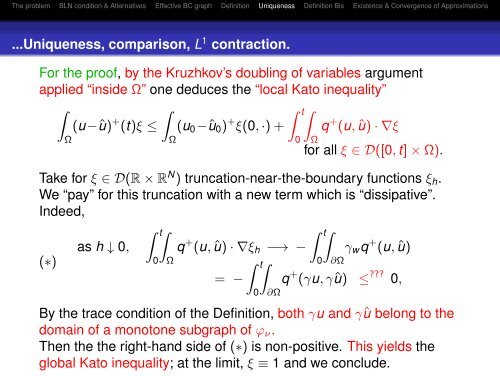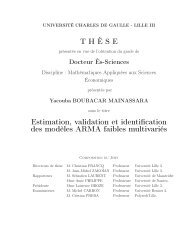Generalizing the Bardos-LeRoux-Nédélec boundary condition for ...
Generalizing the Bardos-LeRoux-Nédélec boundary condition for ...
Generalizing the Bardos-LeRoux-Nédélec boundary condition for ...
You also want an ePaper? Increase the reach of your titles
YUMPU automatically turns print PDFs into web optimized ePapers that Google loves.
The problem BLN <strong>condition</strong> & Alternatives Effective BC graph Definition Uniqueness Definition Bis Existence & Convergence of Approximations<br />
...Uniqueness, comparison, L 1 contraction.<br />
For <strong>the</strong> proof, by <strong>the</strong> Kruzhkov’s doubling of variables argument<br />
applied “inside Ω” one deduces <strong>the</strong> “local Kato inequality”<br />
<br />
(u−û) + <br />
(t)ξ ≤ (u0−û0) + t<br />
ξ(0, ·) + q + (u, û) · ∇ξ<br />
Ω<br />
Ω<br />
0<br />
Ω<br />
<strong>for</strong> all ξ ∈ D([0, t] × Ω).<br />
Take <strong>for</strong> ξ ∈ D(R × RN ) truncation-near-<strong>the</strong>-<strong>boundary</strong> functions ξh.<br />
We “pay” <strong>for</strong> this truncation with a new term which is “dissipative”.<br />
Indeed,<br />
t<br />
(∗)<br />
as h ↓ 0,<br />
0<br />
q<br />
Ω<br />
+ t<br />
(u, û) · ∇ξh −→ −<br />
0<br />
γwq<br />
∂Ω<br />
+ t<br />
(u, û)<br />
= − q + (γu, γû) ≤ ??? 0,<br />
By <strong>the</strong> trace <strong>condition</strong> of <strong>the</strong> Definition, both γu and γû belong to <strong>the</strong><br />
domain of a monotone subgraph of ϕν.<br />
Then <strong>the</strong> <strong>the</strong> right-hand side of (∗) is non-positive. This yields <strong>the</strong><br />
global Kato inequality; at <strong>the</strong> limit, ξ ≡ 1 and we conclude.<br />
0<br />
∂Ω
















